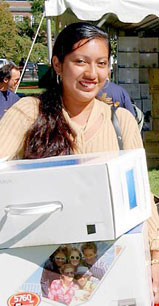Introduction
Next >
 The history of the Computing Services group at Dartmouth, now known as Peter Kiewit Computing Services, spans nearly 40 years. Of the many contributions Dartmouth has made to the world of computing and information technology — the development of BASIC, the development of remote computing networks — one fact stands out.
The history of the Computing Services group at Dartmouth, now known as Peter Kiewit Computing Services, spans nearly 40 years. Of the many contributions Dartmouth has made to the world of computing and information technology — the development of BASIC, the development of remote computing networks — one fact stands out.
From the time of its invention, the computer was a totem, a special object that was attended to by a select group of specialists. Few people, besides white-coated researchers, had ever laid hands on a computer.
John Kemeny and Tom Kurtz, the Dartmouth professors whose names are synonymous with an era of computing here, envisioned a day when students, faculty, and administrators — ordinary people — could use computers for any conceivable purpose, with extraordinary results.
Their vision created an environment that was largely unique in higher education for many years. Dartmouth was among the first institutions to wire its campus, among the first to require incoming students to own a personal computer. It is consistently mentioned as one of the country's most-wired — and, now, wireless — schools.
 But Dartmouth Computing isn't just about history. As a leader in collaborative research projects such as Internet2 and as the home of the Institute for Security Technology Studies, with ongoing research and experiments in wireless communications and instructional technology applications, Dartmouth remains at the cutting edge — while staying focused on delivering excellent services and support to the entire community.
But Dartmouth Computing isn't just about history. As a leader in collaborative research projects such as Internet2 and as the home of the Institute for Security Technology Studies, with ongoing research and experiments in wireless communications and instructional technology applications, Dartmouth remains at the cutting edge — while staying focused on delivering excellent services and support to the entire community.
This timeline is designed to provide an overview of Dartmouth's computing history, from the early 1960s to the present. Special thanks to Tom Byrne, who created the outline that this timeline is based upon; to Margot Neebe, Marie Stebbins, and Ellen Kanner for updating the timeline; and to Jed Sturman for assembling the original web pages. Jay Collier was the executive producer. If you wish to comment or point out an error, please send an e-mail to Ellen Young.
Next >
